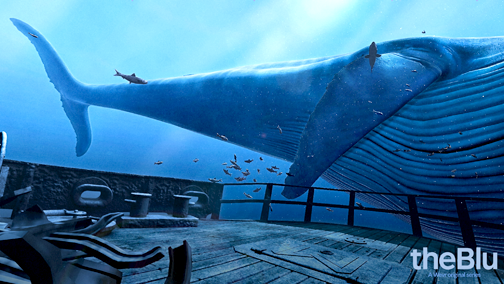
By Charly SHELTON
It’s all fine and good to sit in a room, comfortable and dry, and read about the depths of the ocean in a book or see it on TV. You get the facts, see some fish pictures and you get it. But what about actually inhabiting the space? Going underwater to stand on the edge of a sea cliff, getting up close to fish and whales and sea turtles, or petting a sea anemone which shrinks up at your touch. Being able to interact with these denizens of the deep in their own habitat gives one a clearer picture of what those learned facts mean. But the scuba lessons, the trip to Australia’s Great Barrier Reef, the time off from work and the inconvenience of being wet and cold all the time make it harder to actually experience the ocean on its own terms.
But not anymore. Thanks to VR technology, we can go under the sea in the most realistic way possible while still staying dry. theBlu: An Underwater VR Experience is now open at the Natural History Museum of Los Angeles and it gives guests a chance to see the ocean from within, no rebreather required. Developed by WeVR, a Venice Beach based virtual reality studio, the experience takes guests on a six-minute journey through three different locales of the ocean to meet the animals that live there and just experience the space. From the blue whale encounter on a sunken ship to the migration swarms of jellyfish at the edge of a coral reef to the bottom of the ocean where bioluminescent fish swim by, this is an immersive experience that may change the way guests think about the ocean. For example, I never thought of the bottom of the ocean as being a scary place, but when you’re standing down there with a flashlight as your only source of light and something glowing darts past your leg, it’s understandable to scream like a little girl. Even though it’s digital, even though you know it’s not real, that gut reaction from being in that space is visceral and totally understandable.
“Here’s what it’s like, from someone who has done a lot of SCUBA diving: it’s cool to see all those plants and animals, and not be underwater and cold – especially the deep-sea chapter, where you couldn’t even dive in real life,” said Dr. Chris Thacker, NHMLA fish curator, in a released statement. “It’s incredible to see all the animals up close, particularly the whale and the turtle, and interact with jellyfish and see how they respond. The experience is scientifically accurate and does a good job of replicating what it’s like underwater, but you’re just standing there, warm and dry.”
The experience is scientifically correct because WeVR consulted heavily with museum scientists in the creative process of the project to make sure that it was designed correctly from the early stages. The end result is a new way to look at the ocean, and a new way to look at learning in the future. I, for one, can’t wait until there is an immersive experience like this for dinosaurs or ancient civilizations. VR is still an emerging medium and with projects like theBlu it is apparent that the technology is here now and will be used, hopefully, more frequently in the future.
For those like myself who get violently ill from virtual reality experiences like Google Cardboard videos, fret not. The motion sickness felt in VR experiences comes from a disagreement between the eyes and ears. Your eyes say you’re moving, for example walking down a hallway in a haunted house, but your ears say you’re sitting on a couch. This makes the wearer dizzy and that’s usually when the glasses come off. But with theBlu, this is not the case. Guests are fitted with an HTC Vive headset and headphones, as well as a hand controller to interact with the environment, and then their movement is tracked within the roughly 10-foot-square space, called a pod. So guests can roam freely, getting up close to animals, kneeling down to sea anemones, and can even use the controller to poke at jellyfish as they swim by, all while not getting sick.
theBlu: An Underwater VR Experience is now open at the Natural History Museum of Los Angeles and runs through April 28. Timed tickets are available now at NHM.org, so be sure get yours before the tide rolls out.
